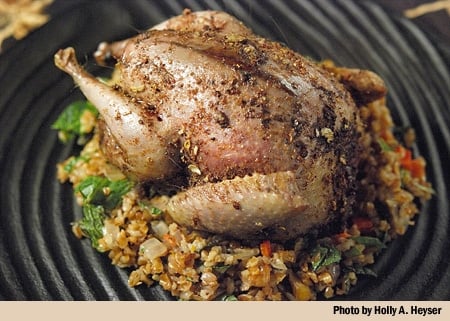No one cooks pigeons the way the Muslims do. Period. From Morocco to Persia, the Islamic world loves its pigeon — squab is just a young, domestically raised pigeon.
This recipe is inspired by the Hamam Mahshi bil Bughul recipe in Claudia Roden’s The New Book of Middle Eastern Food, which has lots of pigeon recipes. I made the Turkish version; the original is from Egypt, where raising pigeons is an art.
I use wild pigeons, which are not as tender as squab but which have far more flavor. Seasons on them are liberal — there is none in California — and if you shoot barn pigeons fat on grain, they are wholesome and delicious. I don’t recommend eating city pigeons.
The key to cooking with wild pigeons is to brine them for 6-12 hours first. This keeps them from drying out in the cooking process, just like a turkey. I use a solution of 1/4 cup kosher salt to 4 cups water.
The stuffing can be made in advance, but everything should be eaten hot in the end. To drink I’d recommend a medium-bodied red wine, or, to be Turkish, some raki.
[yield]Serves 2. [/yield]
- 2 pigeons, whole and plucked
- 3 cups game bird or chicken stock
- 1 cup bulgur wheat
- Kosher salt
- 1 minced onion
- 1/2 cup chopped walnuts
- 2 tablespoons butter or oil
- 1/2 cup chopped mint
- 1 teaspoon cinnamon
- 1/2 teaspoon allspice
- 1 teaspoon ground cardamom
- 2 celery sticks
- Juice of a lemon
- Brine your pigeons in the salt solution I refer to above for 6-12 hours in the fridge.
- Bring the chicken stock to a simmer in a pot, then add the cinnamon, cardamom, about 1 teaspoon of salt and the allspice. Add the bulgur, cover and simmer gently for 15 minutes, or until the wheat absorbs the liquid.
- Meanwhile, heat the oil in a pan over medium-high heat and fry the onions and walnuts, stirring often, until they begin to color. Turn off the heat.
- Preheat the oven to 350 degrees.
- When the bulgur is done, add it to the onion-walnut mixture and stir to combine. Let it cool for 5-10 minutes, stirring occasionally to release the heat. When it is cool, add the mint and a little lemon juice and mix well. Stuff each bird with some of the mixture, but not too much, as it will expand a bit. Leave the remaining bulgur in the pan.
- In another, oven-proof pan (cast iron is ideal), lay the pigeons breast side down. Use the celery sticks as props to keep them in place. Roast this way for 25 minutes.
- Turn the birds over and roast for another 10 minutes, then turn the heat to 500 degrees and roast for a final 10 minutes — this is to brown and crisp the breast meat. Remove and let the pigeons rest for 5-10 minutes. Heat up the bulgur mixture in the pan over low heat. Serve the pigeons on a bed of bulgur, top with a little lemon juice and some fleur de sel, if you have any.
